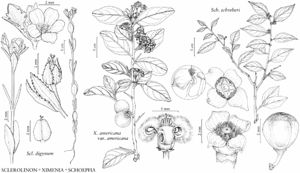Difference between revisions of "Schoepfia schreberi"
Syst. Nat. 1: 376. 1791.
FNA>Volume Importer |
FNA>Volume Importer |
||
| Line 30: | Line 30: | ||
|elevation=0–10 m. | |elevation=0–10 m. | ||
|distribution=Fla.;West Indies;n South America. | |distribution=Fla.;West Indies;n South America. | ||
| − | |discussion=<p>The species concept used here follows the broad view of H. Sleumer (1984), who considered many of the named variants of Schoepfia schreberi to be synonyms. Although they display variable vegetative morphology, flower and fruit morphology appears relatively constant. The floral biology of S. schreberi requires investigation. Sleumer indicated that anthers in pin flowers lack pollen; however, P. B. Tomlinson (1980) stated that the heterostylous condition is apparently efficient, given that trees of both forms set fruit. Root parasitism of ten host species was documented by C. R. Werth et al. (1979).</p> | + | |discussion=<p>The species concept used here follows the broad view of H. Sleumer (1984), who considered many of the named variants of <i>Schoepfia schreberi</i> to be synonyms. Although they display variable vegetative morphology, flower and fruit morphology appears relatively constant. The floral biology of <i>S. schreberi</i> requires investigation. Sleumer indicated that anthers in pin flowers lack pollen; however, P. B. Tomlinson (1980) stated that the heterostylous condition is apparently efficient, given that trees of both forms set fruit. Root parasitism of ten host species was documented by C. R. Werth et al. (1979).</p> |
|tables= | |tables= | ||
|references= | |references= | ||
| Line 54: | Line 54: | ||
|publication year=1791 | |publication year=1791 | ||
|special status=Selected by author to be illustrated | |special status=Selected by author to be illustrated | ||
| − | |source xml=https://jpend@bitbucket.org/aafc-mbb/fna-data-curation.git/src/ | + | |source xml=https://jpend@bitbucket.org/aafc-mbb/fna-data-curation.git/src/8f726806613d60c220dc4493de13607dd3150896/coarse_grained_fna_xml/V12/V12_792.xml |
|genus=Schoepfia | |genus=Schoepfia | ||
|species=Schoepfia schreberi | |species=Schoepfia schreberi | ||
Revision as of 15:49, 18 September 2019
Shrubs or trees, 1.3–7(–9) m; bark whitish, corky, fissured; branches striate, olive green to whitish, slender. Leaf blades lanceolate, ovate, or elliptic, 4–8 × 2–4 cm, brittle, base cuneate-attenuate to obtuse, apex acuminate, both surfaces shiny, ± tuberculate; venation brochidodromous, midrib sunken on both surfaces, lateral veins 4–6 pairs. Inflorescences 1–2 per axil, each a 2–3-flowered cyme or solitary flower; peduncle 1–4 mm. Flowers of two forms, pin and thrum; calyx rim entire or slightly lobed, 1 mm; corolla tube yellow or orange and lobes pink to red, urceolate to cylindric, 4.5 mm (pin flowers), cylindric to campanulate, (3.5–)4(–5) mm (thrum flowers); stigma 2–3-lobed, at or distal to included anthers (pin flowers) or proximal to exserted anthers (thrum flowers); ovary 2-locular in 4-merous flowers, 3-locular in 5-merous flowers. Drupes pink, orange, or red, subovoid to ellipsoid, (7–)10–13 × (6–)7–8 mm, with persistent rim of corolla at apex.
Phenology: Flowering Oct–Mar; fruiting Oct–Mar, soon after flowering.
Habitat: Pinelands, coppices, hammocks, limestone and sand substrates.
Elevation: 0–10 m.
Distribution

Fla., West Indies, n South America.
Discussion
The species concept used here follows the broad view of H. Sleumer (1984), who considered many of the named variants of Schoepfia schreberi to be synonyms. Although they display variable vegetative morphology, flower and fruit morphology appears relatively constant. The floral biology of S. schreberi requires investigation. Sleumer indicated that anthers in pin flowers lack pollen; however, P. B. Tomlinson (1980) stated that the heterostylous condition is apparently efficient, given that trees of both forms set fruit. Root parasitism of ten host species was documented by C. R. Werth et al. (1979).
Selected References
None.
